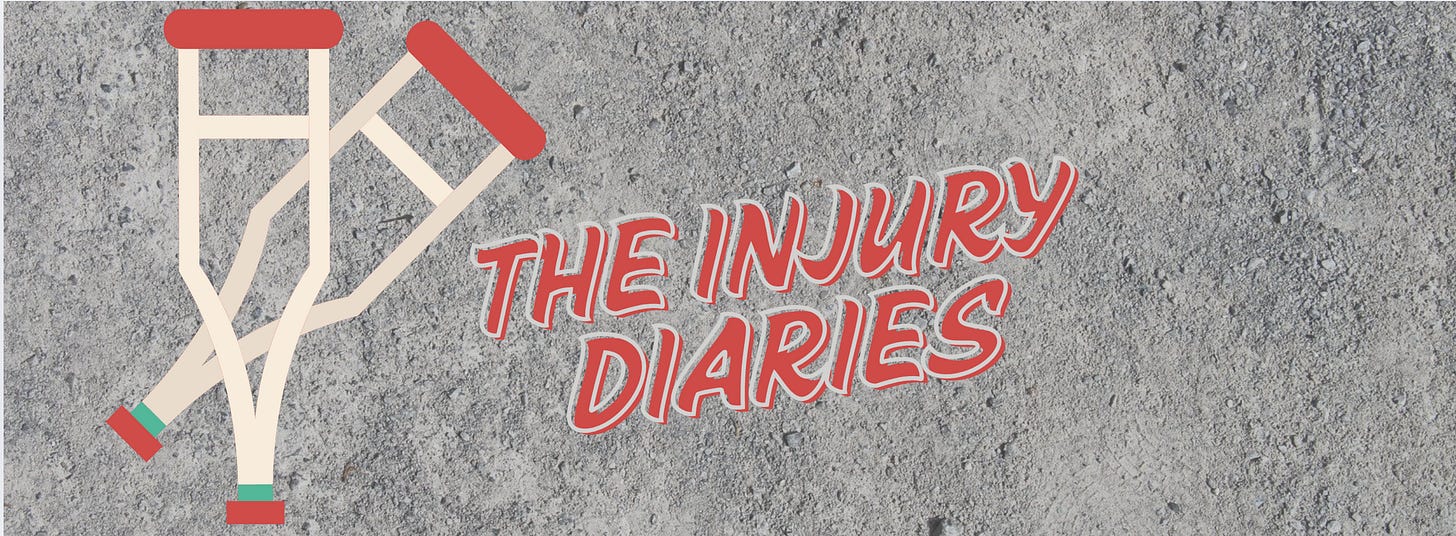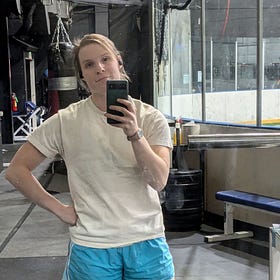Sunday, I took a slight risk.
At the gym, after riding the exercise bike for 15 minutes and doing a few light rounds on the hamstring curl and quad extension machines — my first “leg day” since before surgery — I sat on a plyometric box, held a kettlebell on my left knee, and did about 50 calf raises on my recovering ankle.
I didn’t have permission to do this. While my physical therapist had me do a couple standing exercises the previous week, all my home exercises were still seated with my foot dangling in the air, tugging against an elastic band in all directions. But a combination of noticing how much my left calf had shrunk relative to my right and the sense that a few calf raises might help me toward the goal of being able to fully extend my foot was enough to convince me to go for it.
The next day, back to my regular PT exercises, I pressed my foot into the pull of a band, trying my best to point my toes. Ever since my surgeon had given the okay in mid-March to extend my foot, my focus had been on regaining the range of motion I’d lost when my foot was casted and booted up. I’d already seen progress — enough to send weird foot-sort-of-pointing photos to friends. Look! My pointing is getting better!! But Monday night, the progress could have been identified by someone who hadn’t seen how bad my range of motion was before. I was several degrees shy of full extension, and the gap was close to closing.
Then, Wednesday, two days later, I rushed through my PT exercises before a friend stopped by, and my toe pointing was even better — we’re talking 2-5 degrees shy of matching my other foot. What!
In my head, the leap in progress was directly tied to those random calf raises the day before, but:
The seated calf raises weren’t the first time I’d gone off-script with my exercises. A couple weeks earlier, I’d started stretching the front of my ankle by folding my leg across my lap and pulling on my foot with my hand. The next time I saw my physical therapist, she instructed me to stretch in exactly the same way, which made me more confident that I should listen to my body’s urges to move.
Last week, the outside of my ankle started aching to stretch, and my therapist, when I told her, encouraged me to “lean in — but,” she caught herself, “not actually. Don’t put weight on it. Just, like, stretch it.” “Yeah, I got you,” I replied.
This week, my instincts had me:
Pulling my knee back between ankle flexion stretches in an attempt to help the muscles on the front of my ankle relax
Trying to engage the muscles at the back of my heel when I did the lap stretch from earlier so my toe pointing would improve without my foot’s arch looking like a crescent moon
Doing a few standing calf raises between calf stretches against the wall
Back at PT on Thursday, my therapist celebrated my increased range of motion and then set me up against a ledge for — I bet you can guess it — calf raises.
“Have you been doing these?” she asked.
“Not … prescriptively,” I responded.
“Instinctively?”
“Yeah.”
“Great!”
I did a few plain calf raises, and then she set me up with a ball between my heels to garner more engagement from the inside of my foot. It was harder. I did my best to go slow and controlled, grimacing at the familiar pain flaring from the front of my ankle.
I’ll be honest: it feels good to be affirmed in following my body’s instinctual urges for movement. Despite what living with a chronic ankle injury for 15+ years might suggest, I’ve long prided myself on being tuned into my body. Over the years, I’ve used a mix of intuition, Google, and memories from elementary school gymnastics sessions to develop stretching sequences that help my neck, upper back, and hips feel better.
It’s seemed like my body knows what my body needs, even if my mind doesn’t — but is that crazy? I can picture the faces of friends and family responding to me saying something like that or, “My legs are itching to run,” like I would say in college, walking back to my dorm with friends after dinner. I know how these things sound, but is it all that different from a baby reaching for their toes? Or bouncing their legs when they’re held, standing, on someone’s lap?
The body was made to move. It has a remarkable ability, in many cases, to heal itself. And movement is medicine, so it stands to reason that on the path to rehabilitating an injury, what the body itches for movement-wise might just align with what physical therapists are trained to have their patients do.
Seeing those physical urges to move line up with my physical therapy sessions is helping rebuild trust in my body.
I still have flashing moments of imagining my ankle cave on a misstep. A few nights ago, instead of the falling dream that wakes you up with a start, I dreamt that I turned my ankle again — and I jolted to consciousness. The same image occurs to me every once in a while when I’m fully awake. I’m afraid that after going through all of this — the surgery, the months of healing and recovery — I’ll step wrong on a trail or sidewalk or street and I’ll be right back to where I was. Loose, messed-up ankle that can’t seem to hold it together. More damage to the joint. Arthritis before I’m 40.
But that itch in my ankle to move, to stretch, to push itself, expand its range, testifies of an intelligence that gives me hope. It’s not just my mind that wants my ankle to heal. My body does too.
My ankle wants to be whole, and it’s working with my conscious self to make that happen.
You're not the only one.
Last Sunday, in the lobby after church, a guy came up to me and asked me about my cast. I remembered that he’d been on crutches last summer, showed up to our children’s ministry in a boot and mentioned to other volunteers that he’d broken a bone without even knowing it. (Me too, apparently.)
But what about my muscles? 😢
I know this is a pretty gym bro thing to say, but one of my main concerns with being in a cast or boot for 6-8 weeks is: how much muscle mass am I going to lose?
Recommended Reads
Protein: All you need to know to grow (Body Type by
)Who’s Coming Clean About Steroids? (NY Times)
Fat Girl, Fit Woman: The Lies We’re Told, The Lies We Live (HerPace by
)
What’s coming next?
More Injury Diaries orrrr a history-based thought piece








